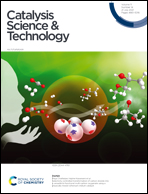Eosin Y-sensitized rose-like MoSx and CeVO4 construct a direct Z-scheme heterojunction for efficient photocatalytic hydrogen evolution
Abstract
The construction of heterojunctions is considered to be an important strategy to improve the performance of photocatalytic hydrogen production and has received more and more attention in recent years. In this work, a simple hydrothermal method was used to prepare a MoSx/CeVO4 composite. The rose-like MoSx has a layered structure that exposes more active sites, which effectively improves the photocatalytic performance of the composite material. MoSx was successfully grown on the surface of irregular bulk CeVO4 by a hydrothermal method, and the optimal hydrogen production reached 295.24 μmol in 5 h. The main reason for the improved hydrogen production performance is that the direct Z-scheme heterojunction constructed between the two semiconductors inhibits the recombination of electron–hole pairs in MoSx/CeVO4. Photoelectrochemical experiments and UV-vis diffuse reflectance spectra were used to roughly determine the direction of electron transfer between MoSx and CeVO4, and further proved that the construction of a direct Z-scheme heterojunction promotes the separation of electron–hole pairs and can effectively improve the performance of hydrogen production. In addition, photoluminescence spectra further proved that the recombination of electron–hole pairs inside the composite material is effectively suppressed. The preparation of MoSx/CeVO4 has injected new vitality into the production of new energy in the future.



 Please wait while we load your content...
Please wait while we load your content...